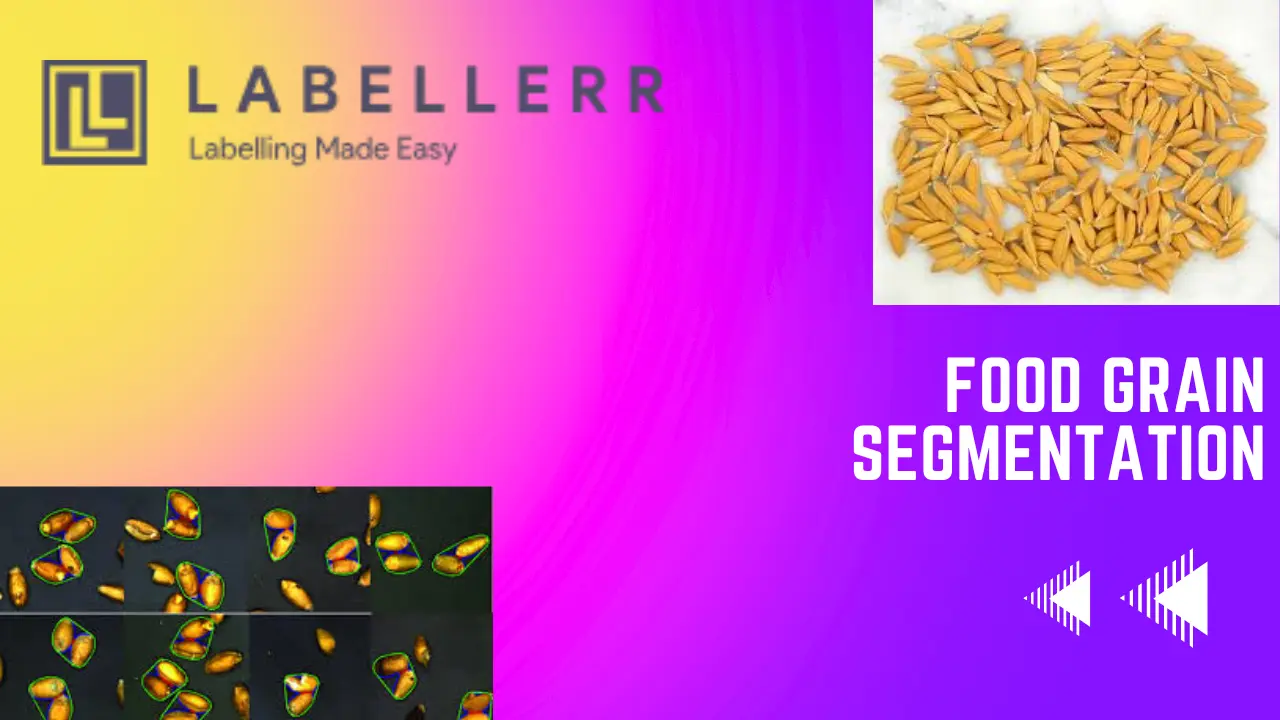Speed Up Food Grain Segmentation Annotation Using Labellerr

Introduction
In modern agriculture, the ability to accurately segment and count food grains using computer vision technology marks a transformative change in precision farming.
By using algorithms and image analysis techniques, farmers can now obtain granular insights into grain production, quality assessment, and yield estimation.
This capability holds immense promise for optimizing resource allocation, enhancing crop management practices, and ultimately improving agricultural productivity. However, it requires proper annotated datasets.
Labellerr an innovative annotation platform, addresses the challenge of annotating food grain images.
By offering advanced annotation tools and capabilities specifically for agricultural applications, Labellerr allows farmers and agricultural researchers to create accurate and reliable datasets essential for training cutting-edge food grain segmentation models.
Table of content-
- Challenge
- Solution Using Labellerr for Food Grain Segmentation
- Conclusion
- FAQ
Challenge
The task of grain segmentation presents a myriad of complex challenges deeply entrenched in the intricacies of agricultural imaging and analysis.
One of the primary challenges lies in the diverse nature of grain shapes and sizes, from tiny seeds to larger seeds, each requiring proper annotation to capture their unique attributes accurately.
Moreover, grains often exist in cluttered backgrounds such as soil, vegetation, or other grains, leading to occlusions and overlaps that obscure individual grains and complicate their segmentation.
Navigating through these complex backgrounds while accurately annotating each grain requires a high level of precision and expertise from annotators.
Images captured under different lighting conditions may show inconsistencies in contrast and quality, posing hurdles to achieving consistent and reliable annotations across datasets.
When it comes to food grain segmentation, particularly with images containing a large volume of rice grains, the focus is on annotating each individual grain. This means meticulously separating each grain from its neighbors, capturing its unique shape and size.
By segmenting the image, we can accurately count the number of grains, measure their size and shape, and even identify defects or contaminants.
Manually segmenting each grain in an image is very slow and prone to errors. The sheer number of clicks required to trace every grain boundary makes it highly time-consuming.
Overcoming these challenges requires a concerted effort to develop robust annotation techniques capable of producing high-quality labeled datasets essential for training accurate instance segmentation models in agriculture.
Solution Using Labellerr for Food Grain Segmentation:

Intuitive Interface
Labellerr offers an intuitive interface designed to simplify the annotation process for food grain instance segmentation and counting.
With user-friendly navigation tools and clear labeling options, annotators can easily identify and annotate individual grains within images.
The intuitive interface minimizes the learning curve, allowing annotators to focus on the task at hand without being hindered by complex annotation tools.
Cost Savings
Labellerr facilitates significant cost savings for agricultural operations by optimizing the annotation process and reducing manual labor costs.
Its advanced automation features automate repetitive tasks, such as image uploading and annotation management, minimizing the need for extensive human intervention.
By streamlining the workflow, Labellerr enables efficient annotation of large datasets, ultimately saving time and resources for agricultural organizations.
Robust Segmentation Features
Labellerr incorporates robust segmentation features, including the Segment Anything Model (SAM), specifically tailored for food grain segmentation and counting tasks.
SAM's advanced algorithms excel at accurately delineating individual grains within images, regardless of variations in shape, size, or occlusions.
By leveraging SAM's segmentation capabilities, Labellerr ensures the precision and reliability of annotated datasets, essential for training accurate segmentation and counting models in agriculture.
Custom Workflows
Labellerr supports customizable workflows tailored to the unique requirements of food grain segmentation projects.
Users can define custom annotation protocols, designate food grain categories, and customize labeling criteria to align with specific project objectives.
This flexibility enables annotators to adapt the annotation process to suit the nuances of different grain types and environmental conditions, ultimately enhancing the accuracy and effectiveness of segmentation and counting models.
Active Learning Based Labeling
Labellerr integrates active learning techniques to optimize the annotation process for food grain segmentation.
By intelligently selecting the most informative samples for annotation, Labellerr maximizes the efficiency of data labeling, reducing manual effort while improving the performance of trained models.
This active learning-based approach enables agricultural professionals to prioritize labeling efforts on data points that are most beneficial for model training, ultimately leading to more accurate and effective food grain segmentation models.
Automated Import and Export of Data
Labellerr streamlines the process of importing and exporting data for grain segmentation tasks with its automated functionalities.
Whether integrating data from drones, sensors, or other sources, Labellerr simplifies the data management process, enabling seamless integration of datasets into the annotation platform.
Similarly, Labellerr facilitates the export of annotated data, ensuring compatibility with various machine learning frameworks for model training and deployment.
Collaborative Annotation Pipeline
Labellerr fosters collaboration among agricultural professionals with its collaborative annotation pipeline.
Multiple users can work simultaneously on annotating images of grains, enabling distributed workflows and real-time collaboration.
This collaborative approach enhances productivity and ensures consistency and accuracy in the labeled dataset, ultimately improving the performance of grain segmentation models.
Conclusion
In conclusion, Labellerr emerges as a pivotal tool in advancing grain segmentation and counting through its comprehensive annotation solutions.
By addressing the complex challenges associated with annotating agricultural images, Labellerr empowers agricultural professionals to create accurate and reliable datasets essential for training cutting-edge segmentation models.
With features such as active learning-based labeling, automated import and export of data, collaborative annotation pipelines, and automated quality assurance, Labellerr streamlines the annotation process, enhances productivity, and ensures the consistency and accuracy of labeled datasets.
As a result, Labellerr facilitates the development of precise and effective food grain segmentation and counting models, ultimately contributing to improved crop management, yield estimation, and resource allocation in agriculture.
Frequently Asked Questions
Q1) What is food grain segmentation and counting?
Food Grain segmentation and counting involve using computer vision technology to identify and quantify individual grains within images, enabling precise analysis of grain distribution and density.
Q2) How does Labellerr assist in annotating images for grains instance segmentation ?
Labellerr provides advanced annotation tools and features tailored specifically for grains instance segmentation tasks.
Its intuitive interface, robust segmentation capabilities, and collaborative annotation pipeline streamline the annotation process, enabling efficient and accurate labeling of grain images.
Book our demo with one of our product specialist
Book a Demo
